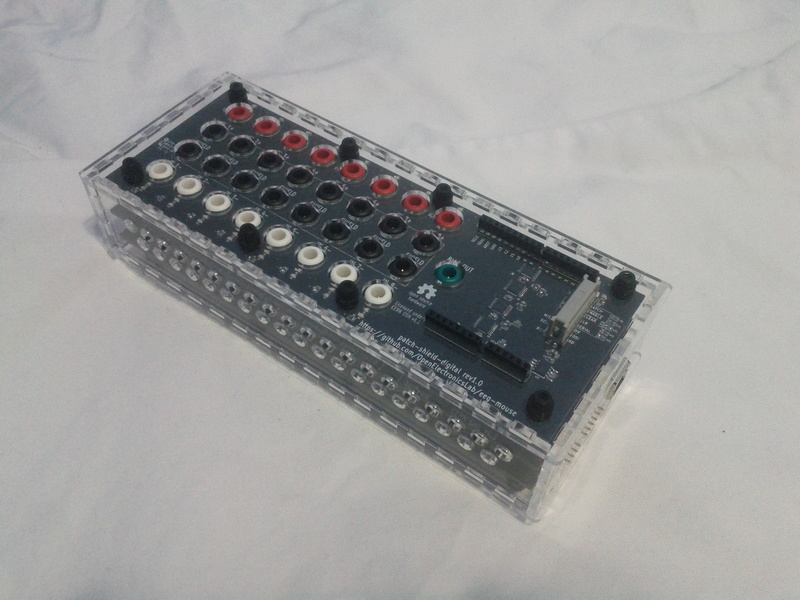[Eric] tipped us about the OpenHarwareExG project which goal is to build a device that allows the creation of electrophysiological signal processing applications. By the latter they mean electrocardiography (ECG, activity of the heart), electroencephalography (EEG, signals on the scalp), electromyography (EMG, skeletal muscles activity), electronystagmography and electrooculography (ENG & EOG, eye movements) monitoring projects. As you can guess these signals are particularly hard to measure due to their small amplitude and therefore susceptibility to electrical noise.
The ADS1299 8-channel 24-bit analog front end used in this platform is actually electrically isolated from the rest of the circuit so the USB connection wouldn’t perturb measurements. An Arduino-compatible ATSAM3X microcontroller is used and all the board is “DIY compatible” as all parts can be sourced in small quantities and soldered by hand. Even the case is open source, being laser cut from acrylic.
Head to the project’s website to download all the source files and see a quick video of the system in action.
Interested in measuring the body’s potential? Check out an ECG that’s nice enough to let you know you have died, or this Android based wireless setup.
















If it can be certified great, otherwise we will still have to use very expensive “blessed” gear. Medical and even educational electronics seem to be made of unobtainium and delivered by gravy train.
When someones life depends on an ECG machine that correctly displays a faulty heart rhythm, you want that ECG machine and its design to have been vetted by people who know how to test these things properly.
EEG on the other hand is not so critical (risk of brain frying aside).
No, you just commit them the lifelong toxic medical therapy, force the women to sign contracts saying they won’t get pregnant (and sue for the Foetal malformation the drugs cause), take off their license, prevent them ever becoming divers, pilots, working in heavy industry, prohibit swimming and tell them they have increased risk of death anyway, which the drugs can reduce but not eliminate.
Or, lose the opportunity to control their siezures, die in a car crash, die in a plane crash (and kill others doing so), drive an excavator off a cliff, drown, and die of sudden unexplained death in epilepsy (SUDE) much of which can be ameliorated by appropriate medication.
And we can do other tests for a heart attack.
However, until/ unless a medical device is “certified” – usually in an open and challengeable oversight process to ensure drugs like thalidomide and fraudulent pseudo-science devices
A) Work
B) Do no/minimal/acceptable harm
C) Do so reliably
D) are manufactured in a manner such as to continue to meet these goal in the future / next batch
As someone that suffers from epilepsy an EEG is very critical.. Generally I am tested every couple of years to see how much activity there is. Whether or not my medications are keeping it at bay.. Knock on wood my medication has kept it at bay for a number of years, but its scary to see how much activity is still there..
I am a complete NOOB.
A project that I have been trying to figure out is to listen to a baby’s heartbeat, does this project in anyway help?
For baby’s use ultrasound echo toco transducer..
You can use a special “foetal stethoscope” from about 20 weeks (24 minimum for the rest of us).
You can even use a 3d printer to print one if you like.
you’d need a cardiotocogram. It records fetal heart sounds and uters contractions simultaneously.
I had to get an ekg done (sanity check for a shrink visit) and under my current healthcare plan, those bastards charged me $100 for 5 minutes of work!
I did think to build my own unit and I don’t think it would be that hard, really. its not rocket science ;)
the cost of medical electronics is absurd and way overpriced. I’d welcome some ‘disruption’ here.
Finally something to fill the needs from the kickstarter project from several years ago that turned out to be scamware. Both of the things from these 2 SOBs that i backed were basicly just scamware. https://www.kickstarter.com/projects/86514518/diy-arduino-eeg in case anyone would like to get hold of them and beat them with a piece of rail-road iron.
also remember the old but well described ‘openeeg’ project. I build my own for a few years ago. you can se it here http://techmind.dk/dataopsamling/billig-neurofeedback-med-openeeg/
Nice. There’s also the Bitalino platform which uses ProtoSnap blocks, does EMG, EDA and ECG, has a BT module, it’s relatively cheap and has plenty of APIs for different environments http://www.bitalino.com/
Unless it meets the electrical requirements for medical equipment….,
Then you really really do not want to connect it to your body….
And no…. USB does not always run at a safe voltage….., in-fact once you throw a ‘hub’ in there… you may as well throw your life into a rubbish bin…..
USB 1.0 & 2.0 use 5V… it’s true that you could die ;)
Honestly, I’m more concerned about the data reading than the equipment. It takes a lot of practice & training to be able to interpret EEG’s and EKG’s for medical purposes. If you are interested in novelty purposes (ie Mindflex), this kind of setup is probably overkill. It’s not the quantity of the data that matters, it’s the usefulness.
I’m also epileptic and find that simpler data is often more useful.
If someone needs help with this project, I am very interested. I am an Medical Doctor and a Neurophysiologist. I deal with all of these things every day.
Are you interested in Essential Tremors and/or Parkinson’s Disease measurements? If so, please contact me at jlk@pobox.com
I am disappointed in the number of naysayers and alarmists above. Take it for what it is worth and contribute positive and encouraging comments